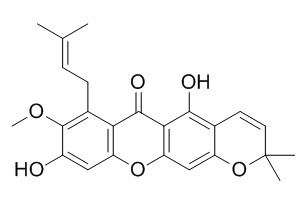9-Hydroxycalabaxanthone
9-Hydroxycalabaxanthone exhibits cytotoxicity against the HT-29 cell line with ED50 values of 9.1 microM. The combination of 9-hydroxycalabaxanthone with α-mangostin shows the synergistic antimalarial interaction in both clones.
Inquire / Order:
manager@chemfaces.com
Technical Inquiries:
service@chemfaces.com
Tel:
+86-27-84237783
Fax:
+86-27-84254680
Address:
1 Building, No. 83, CheCheng Rd., Wuhan Economic and Technological Development Zone, Wuhan, Hubei 430056, PRC
Providing storage is as stated on the product vial and the vial is kept tightly sealed, the product can be stored for up to
24 months(2-8C).
Wherever possible, you should prepare and use solutions on the same day. However, if you need to make up stock solutions in advance, we recommend that you store the solution as aliquots in tightly sealed vials at -20C. Generally, these will be useable for up to two weeks. Before use, and prior to opening the vial we recommend that you allow your product to equilibrate to room temperature for at least 1 hour.
Need more advice on solubility, usage and handling? Please email to: service@chemfaces.com
The packaging of the product may have turned upside down during transportation, resulting in the natural compounds adhering to the neck or cap of the vial. take the vial out of its packaging and gently shake to let the compounds fall to the bottom of the vial. for liquid products, centrifuge at 200-500 RPM to gather the liquid at the bottom of the vial. try to avoid loss or contamination during handling.
The Journal of Internal Korean Medicine2015, 36(4):486-497
Chemistry of Plant Materials.2019, 129-136
J Appl Biol Chem2021, 64(3):245-251.
Antioxidants (Basel).2023, 12(2):447.
Int Immunopharmacol.2019, 71:361-371
J Chromatogr A.2024, 1714:464544.
Asian Pac J Tropical Bio.2020, 10(6):239-247
Int J Mol Sci.2023, 24(20):15320.
Nutrients.2022, 14(23):4997.
J Nat Prod.2015, 78(6):1339-4
Related and Featured Products
Fitoterapia. 2014 Oct;98:215-21.
Mangostanaxanthones I and II, new xanthones from the pericarp of Garcinia mangostana.[Pubmed:
25128900 ]
Two new xanthones: mangostanaxanthones I (3) and II (5) were isolated from the pericarp of Garcinia mangostana, along with four known xanthones: 9-Hydroxycalabaxanthone (1), parvifolixanthone C (2), α-mangostin (4), and rubraxanthone (6).
METHODS AND RESULTS:
Their structures were elucidated on the basis of IR, UV, 1D, 2D NMR, and MS spectroscopic data, in addition to comparison with literature data. The isolated compounds were evaluated for their antioxidant, antimicrobial, and quorum-sensing inhibitory activities. Compounds 3 and 5 displayed promising antioxidant activity with IC50 12.07 and 14.12 μM, respectively using DPPH assay. Compounds 4-6 had weak to moderate activity against Escherichia coli and Staphylococcus aureus, while demonstrated promising action against Bacillus cereus with MICs 0.25, 1.0, and 1.0mg/mL, respectively.
CONCLUSIONS:
The tested compounds were inactive against Candida albicans. However, they showed selective antifungal potential toward Aspergillus fumigatus. Compounds 3 and 4 possessed quorum-sensing inhibitory activity against Chromobacterium violaceum ATCC 12472.
Acta Parasitol. 2014 Mar;60(1):105-11.
The in vitro antimalarial interaction of 9-hydroxycalabaxanthone and α-mangostin with mefloquine/artesunate.[Pubmed:
26204026]
Multidrug resistance Plasmodium falciparum is the major health problem in Thailand. Discovery and development of new antimalarial drugs with novel modes of action is urgently required. The aim of the present study was to investigate the antimalarial interaction of 9-Hydroxycalabaxanthone and α-mangostin with the standard antimalarial drugs mefloquine and artesunate in chloroquine sensitive (3D7) and chloroquine resistant (K1) P. falciparum clones in vitro.
METHODS AND RESULTS:
Median (range) IC50 (drug concentration which produces 50% parasite growth inhibition) values of the 9-Hydroxycalabaxanthone, α-mangostin, artesunate and mefloquine for 3D7 vs K1 clones were 1.5 (0.9-2.1) vs 1.2 (1.1-1.6) μM, 17.9 (15.7.0-20.0) vs 9.7 (6.0-14.0) μM, 1.0 (0.4-3.0) vs 1.7 (1.0-2.5) nM, and 13.3 (11.1-13.3) vs 7.1 (6.7-12.2) nM, respectively. Analysis of isobologram and combination index (CI) of 9-Hydroxycalabaxanthone with artesunate or mefloquine showed synergistic and indifference antimalarial interaction, respectively. α-mangostin-artesunate combination exhibited a slight antagonistic effect of antimalarial interaction, whereas α-mangostin and mefloquine combination showed indifference interaction in both clones.
CONCLUSIONS:
The combination of 9-Hydroxycalabaxanthone with α-mangostin showed the synergistic antimalarial interaction in both clones.
J Nat Prod. 2009 Nov;72(11):2028-31.
Cytotoxic xanthone constituents of the stem bark of Garcinia mangostana (mangosteen).[Pubmed:
19839614]
METHODS AND RESULTS:
Bioassay-guided fractionation of a chloroform-soluble extract of Garcinia mangostana stem bark, using the HT-29 human colon cancer cell line and an enzyme-based ELISA NF-kappaB assay, led to the isolation of a new xanthone, 11-hydroxy-3-O-methyl-1-isomangostin (1). The structure of 1 was elucidated by spectroscopic data analysis. In addition, 10 other known compounds, 11-hydroxy-1-isomangostin (2), 11alpha-mangostanin (3), 3-isomangostin (4), alpha-mangostin (5), beta-mangostin (6), garcinone D (7), 9-Hydroxycalabaxanthone (8), 8-deoxygartanin (9), gartanin (10), and cratoxyxanthone (11), were isolated. Compounds 4-8 exhibited cytotoxicity against the HT-29 cell line with ED50 values of 4.9, 1.7, 1.7, 2.3, and 9.1 microM, respectively. In an ELISA NF-kappaB assay, compounds 5-7, 9, and 10 inhibited p65 activation with IC50 values of 15.9, 12.1, 3.2, 11.3, and 19.0 microM, respectively, and 6 showed p50 inhibitory activity with an IC50 value of 7.5 microM.
CONCLUSIONS:
Alpha-mangostin (5) was further tested in an in vivo hollow fiber assay, using HT-29, LNCaP, and MCF-7 cells, but it was found to be inactive at the highest dose tested (20 mg/kg).



